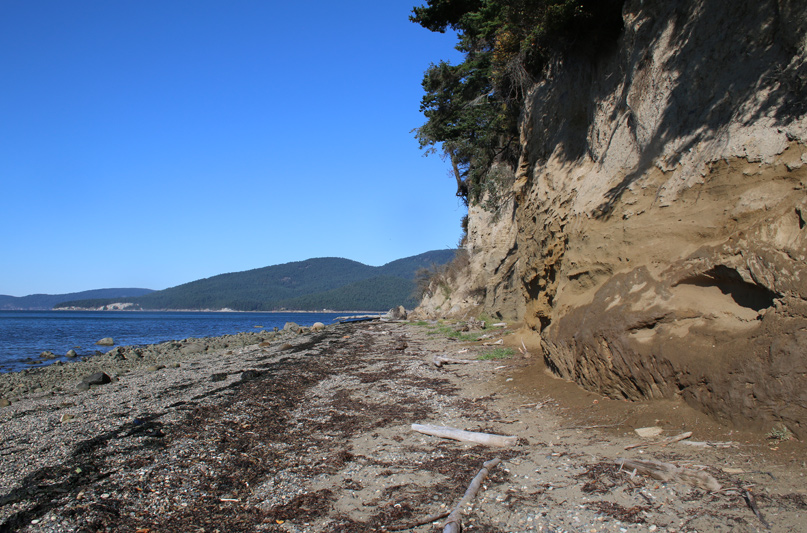
 It’s a cool Saturday morning and the M/V Guemes is on one of its 23 daily runs ferrying vehicles and passengers between Anacortes and Guemes Island. The ferry crosses the mile-wide channel as the new day makes a showy entrance. The awakening sun displaces pre-dawn blues and violets with yellows, oranges, and reds. A tidal change brings a flush of cold, nutrient-rich waters from the Pacific, which in turn attracts sea life high up the food chain. The nearshore air is pungent with the scent of salt and kelp. Seals bob offshore and cormorants in flight skim the water’s surface. Gulls caw and screech as the ferry, which can carry 21 cars, arrives at its namesake island.
It’s a cool Saturday morning and the M/V Guemes is on one of its 23 daily runs ferrying vehicles and passengers between Anacortes and Guemes Island. The ferry crosses the mile-wide channel as the new day makes a showy entrance. The awakening sun displaces pre-dawn blues and violets with yellows, oranges, and reds. A tidal change brings a flush of cold, nutrient-rich waters from the Pacific, which in turn attracts sea life high up the food chain. The nearshore air is pungent with the scent of salt and kelp. Seals bob offshore and cormorants in flight skim the water’s surface. Gulls caw and screech as the ferry, which can carry 21 cars, arrives at its namesake island.
This is a daily experience for the 900 or so people who call the island home. Guemes Islanders are entirely dependent upon the county ferry to get to and from “the mainland.” It’s a four-minute transit, but when the ferry docks for the night, the distance between island and mainland seems infinite.
The feeling that Guemes Island is so close, yet so far away, is part of its attraction to residents and visitors. On one side of Guemes Channel is Anacortes, population 17,000, through which an estimated two million vehicles travel each year to catch the state ferry to San Juan, Lopez, Orcas, Shaw, and Vancouver islands. On the other side of the channel is this bucolic escape: no tall buildings, no downtown, no traffic signals, no busy intersections. Just beaches and bluffs, farms and forests, sea life and wildlife.
Guemes Island has no marinas or docks, but it’s an easily accessible daycation, especially if you’re docked at one of Anacortes’ marinas. Anchor out and drop a crab pot, or kayak over, or do as the locals do and take the Guemes Island ferry. Ride a bicycle around the island, hike Guemes Mountain for the breathtaking view of the San Juan and Gulf islands, walk the beaches, get a massage at the local resort, and catch some live music at the general store (and while you’re there have a bowl of chef William McWatters’s seafood chowder).
STAY AWHILE
GUEMES ISLAND HIGHLIGHTS
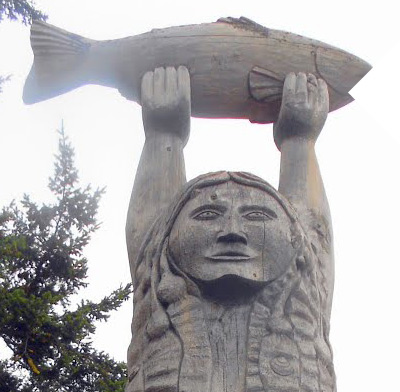 |
What’s in a Name? Dog vs. GuemesGuemes Island is within the historical territory of the Samish people. They knew the island as Qwengqwengíla (pronounced kwuhng kwuhng illuh). “It means ‘lots of dogs’ island,” said Kelly Hall, the Samish Nation’s language program manager. The name is a reference to a dog breed whose wool-like fur was used by the Coast Salish people for weaving. Spanish and English sailing expeditions visited these waters in 1791 and 1792, respectively, and the Spanish expedition leader named the island in honor of the viceroy of Mexico, Juan Vicente de Güemes Padilla Horcasitas y Aguayo. There’s no evidence the Spanish asked the island’s indigenous residents for their opinion—or permission. Coast Salish leaders signed the Treaty of Point Elliott in 1855, which made land in much of Western Washington including Guemes Island available for newcomers. The Samish had a village here until the early 1900s (several Samish people still live on the island). A house post from the last Samish longhouse on the island was returned in 2005 by the Burke Museum to the Samish Indian Nation. Ancestral objects from Guemes Island can be viewed at the Samish Nation-owned Fidalgo Bay Resort in Anacortes. |
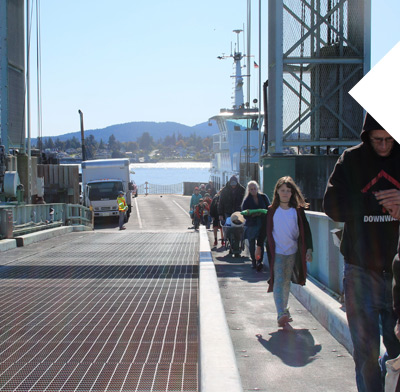 |
M/V GuemesWant to do as the locals do? Make the Guemes Island ferry part of your escape. Sit in the passenger cabin and enjoy the view or stand outside and breathe in the sea air and feel the salty breeze rush through your hair. For four minutes, our increasingly fast-paced and digital world slows a bit. During the transit, a passenger has time to clear his or her head, connect with a neighbor, look for porpoises and seals, ponder the physics involved in a sailboat’s movement, and imagine the destination of a large yacht passing by. The ferry is no respecter of income or social standing. You can live in a cabin or a million-dollar waterfront home – doesn’t matter. If you walk on and have a lot of stuff, you’ll cart your belongings aboard using one of the wheelbarrows available on the dock. You’d better use the restroom in the ferry terminal before boarding; there is no restroom on the vessel. Next year will be the 130th anniversary of passenger ferry service between Anacortes and Guemes Island. The first ferry, a steamer named Iola, began service in 1890, followed by the Glide, Sunny Jim, and Elk, according to a published timeline from the Anacortes Museum. The original Guemes (1917-1959) was replaced by the Almar in 1959. The current Guemes has been in service since taking over for the Almar in 1979. |
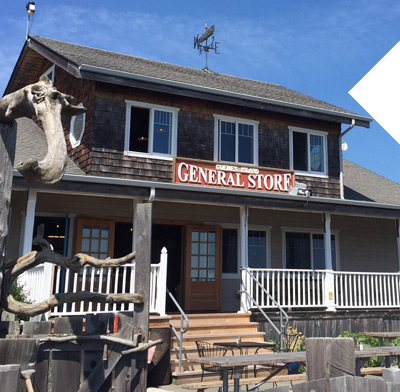 |
Local LifeAfter your day of adventure, unwind at Guemes Island General Store, which features food and drink, live entertainment, an outdoor beer garden, and views of Guemes Channel. The store hosts a summer-long outdoor concert series, in addition to the Summer Solstice Music Fest in June and the Earth Day Luminary Parade. Upcoming events include the art pop singer Laura Hickli on November 9. The Guemes Island General Store is a stone’s throw from the ferry landing and is a good place to stock up on provisions for lunch on the beach or trail (be a good steward; pack it in and pack it out). Still want to take in a movie or shop historic downtown Anacortes? Take the ferry back to Anacortes and take a half-mile stroll to the Old Town commercial district. If you’re boat-based, it’s likely that your boat will be in one of Anacortes’ well-endowed marinas. |
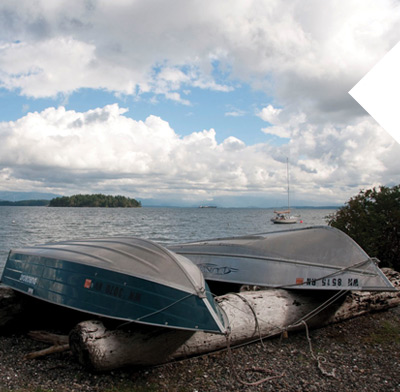 |
Gateway to CypressGuemes Island is known by islanders as Dog Island, a reference to its Samish name; and by kayakers as the Gateway to Cypress Island, three-quarters of a mile to the west. Dennis Stuhaug wrote in 2001 on greatoutdoors.com of his experience kayaking to Cypress Island: “Tiny island deer trot along the beaches, and fox and river otter flash in and out of sight so quickly you’re never certain if you’ve actually seen them. Kingfishers, stilt-legged herons, legions of ducks, and the incredible majesty of the bald eagles fill the air.” Cypress Head and Pelican Beach have gravel beaches, campsites, and pit toilets (but no water). Watch the sun set from 900-foot Eagle Cliff. Be aware of strong tidal rips and eddies around Cypress Head, especially on ebb tide. |
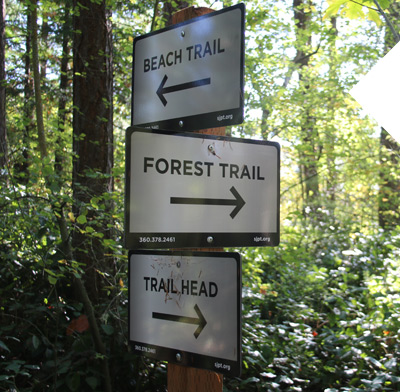 |
Escape to NatureTake a left on South Shore Drive to the 64-acre Peach Preserve, which is owned and managed by the San Juan Preservation Trust and named for philanthropist Patsy “Peach” Bullitt Collins, whose bequest funded the site’s purchase. A conifer forest trail leads to a 13-acre freshwater wetland and 2,100 feet of shoreline on Guemes Channel. At the end of South Shore Drive is Yellow Bluff at Kelly’s Point, a 27-acre preserve owned and managed by the Skagit Land Trust. Kelly’s Point gets its name from Lawrence Kelly, the famous 19th to 20th century smuggler, who made his home near the point in the late 1800s. Pigeon guillemots nest in the sedimentary cliffs towering over the beach, and the upland forest is habitat for raptors and migratory song birds. From the ferry landing, take an immediate right and follow South Shore Road 2.1 miles to the Guemes Mountain trailhead. The mountain is 688 feet and the highest point on Guemes Island. A forested trail leads to a mountaintop prairie that is habitat for a variety of birds and wildflowers, including camas and chocolate lilies; and offers a panoramic view of the San Juan Islands, Mount Baker, the North Cascades, and the Skagit River delta. The mountain was purchased in 2009 and protected from development by a partnership of the Skagit Land Trust, San Juan Preservation Trust, and Guemes Island residents. |
GUEMES ISLAND, WASHINGTON
GASTRONOMY
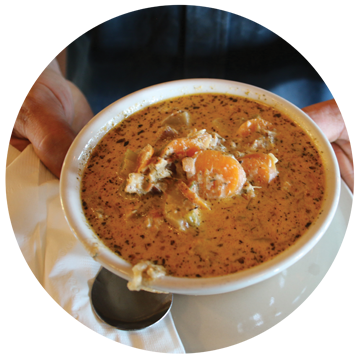
Every region captures its flavor in a bowl. Southerners enjoy Brunswick stew with a side of barbecue at college football tailgate parties. African-Caribbean cuisine may have influenced the City of Brotherly Love’s Pepper Pot, a delectable mixture of tripe, vegetables, and peppercorns. Louisiana gumbo is a delicious mystery, with each cook relying on a “pinch of this” and “just enough of that.” In the Southwest, tortilla soup is a flavorful reminder of that region’s Mexican heritage.
Fine representations, all of their respective region’s cultures. But for many coastal Washingtonians, those cultural celebrations-in-a-bowl can’t compete with seafood chowder served with a side of Salish Sea life.
William McWatters, co-owner and manager of the Guemes Island General Store, concocted this creamy Pacific Northwest chowder filled with locally sourced salmon, cod, clams, vegetables, and herbs. The reddish-brown broth is creamy and fragrant, and each spoonful is chockfull of the goodness of the Salish Sea.
McWatters safeguards his recipe (for good reason), but no matter. The mystery of this chowder is part of the allure of this place. It’s the flavor of the Salish Sea in your bowl; the salty breeze off the channel, the high-pitched piping note of a bald eagle, the rumble of the engine of the approaching ferry.
When the tide is out the table is set, Samish elders say, “Ená ílhen — Come eat!”